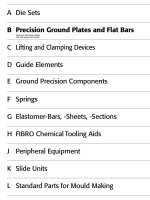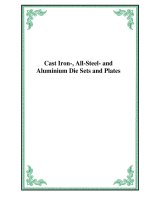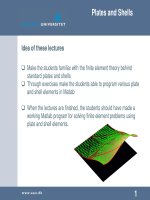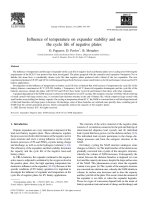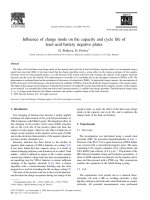Shells and plates
Bạn đang xem bản rút gọn của tài liệu. Xem và tải ngay bản đầy đủ của tài liệu tại đây (3.77 MB, 85 trang )
Plates and Shells
1
Idea of these lectures
Make the students familiar with the finite element theory behind
standard plates and shells
Through exercises make the students able to program various plate
and shell elements in Matlab
When the lectures are finished, the students should have made a
working Matlab program for solving finite element problems using
plate and shell elements.
Plates and Shells
2
Lecture plan
Today
Repetition: steps in the Finite Element Method (FEM)
General steps in a Finite Element program
Investigate the existing Matlab program
Theory of a Kirchhoff plate element
Strong formulation
Weak formulation
Changes in the program when using 3-node Kirchhoff plate elements
Area coordinates
Gauss quadrature using area coordinates
Shape functions for 3-node element
N- and B-matrix for 3-node Kirchhoff plate element
Transformation of degrees of freedom and stiffness matrix
How to include the inplane constant-strain element into the formulation
Laminated plates of orthotropic material
Plates and Shells
3
Lecture plan
Lectures 3+4 (LA)
Degenerate 3-D continuum element
Thick plates and curved shells
Lecture 5 (SRKN)
Various shell formulations
Geometry of curved surfaces
Plates and Shells
4
The finite-element method (FEM)
Basic steps of the displacement-based FEM
Establish strong formulation
Establish weak formulation
Discretize over space
Select shape and weight functions
Compute element matrices
Assemble global system of equations
Apply nodal forces/forced displacements
Solve global system of equations
Compute stresses/strains etc.
Plates and Shells
5
Exercise 1
How do we make a Finite Element program?
What do we need to define? Pre-processing.
What are the steps in solving the finite element problem? Analysis.
What kind of output are we interested in? Post-processing.
Plates and Shells
6
Exercise 2
Look through the program
Determine where the steps discussed in exercise 1 are defined or
calculated in the program
Try to solve the deformation for the following setup using conforming
and non-conforming 4-node elements
Plates and Shells
7
What is a plate?
A plate is a particular form of a three-dimensional
solid with a thickness very small compared with
other dimensions.
Today we look at elements with 6 degrees of
freedom at each node
3 translations (u,v,w) and 3 rotations (
x
,
y
,
z
)
Plate part (w,
x
,
y
)
in-plane (u,v)
zero stiffness (
z
)
We distinguish between thin plate theory
(Kirchhoff) and thick plate theory (Mindlin-
Reissner)
Plates and Shells
8
Thin plate theory
First we assume isotropic homogenous material, i.e. in-plane and
out-of-plane components are decoupled
Only considering the out-of-plane deformations, it is possible to
represent the state of deformation by one quantity, w (lateral
displacement of the middle plane of the plate)
This introduces, as we will see later, second derivatives of w in the
strain description. (Euler-Bernoulli beam theory)
Hence, continuity of both the quantity and the derivative across
elements are necessary for the second derivative not to vanish (C1
continuity).
C0 continuity
C1 continuity
Plates and Shells
9
Strong formulation of the plate problem (thin and thick plates)
Assumptions (first 2D for
simplification)
Plane cross sections remain plane
The stresses in the normal
direction, z, are small, i.e. strains in
that direction can be neglected
This implies that the state of
deformation is described by
Plates and Shells
10
Strain and stress components
Deformations
Strains
Stresses
Stress resultants (section forces)
Plates and Shells
11
Equilibrium equations
Horizontal equilibrium (+right)
Plates and Shells
12
Equilibrium equations
Vertical equilibrium (+up)
Plates and Shells
13
Equilibrium equations
Moment equilibrium around A
(+clockwise)
Plates and Shells
14
Stress resultants in terms of deformation components
Normal force
Shear force
Moment
Rectangular
cross section
Plates and Shells
15
Thin plate approximation
Neglects the shear deformation, G=
The shear force should not introduce infinite energy into the system,
hence
I.e. rotations can be determined from the bending displacement
Including Shear deformation
No Shear deformation
Plates and Shells
16
General three-dimensional case
(disregarding inplane deformations)
Forces
Deformations
Plates and Shells
17
Kinematic relations
Deformations
Strains
See figure slide 16
See slide 15
Plates and Shells
18
Constitutive relation
Isotropic, linear elastic material
Plates and Shells
19
Section moments and shear forces
Moments
Using the constitutive (slide 18) and kinematic (slide 17) relations we
get
Shear forces
Plates and Shells
20
Equilibrium equations
2D
3D
Combining
Plates and Shells
21
Thin plates
Shear deformations out of plane are disregarded, I.e.
Equilibrium equation (strong formulation of the thin plate)
Plates and Shells
22
Weak formulation (Principle of virtual work)
Internal virtual work
External virtual work
distributed load nodal load line boundary load
Definition
Plates and Shells
23
Finite-element formulation
Galerkin approach, physical and variational fields are discretised
using the same interpolation functions
The variation of the sum of internal and external work should be
zero for any choice of u
FEM equations
Consistent area load
nodal load
Plates and Shells
24
Triangular elements
3 Nodes, 6 global degrees of freedom per node
Plates and Shells
25
Exercise 3
What do we need to change in the program when using 3-node
elements (6 global DOF per node) compared with 4-node elements
(6 global DOF per node)?
Make the following setup using 3-node elements
